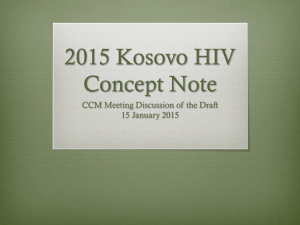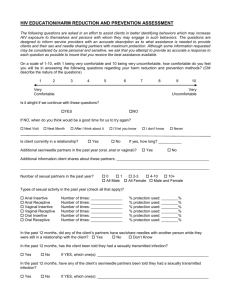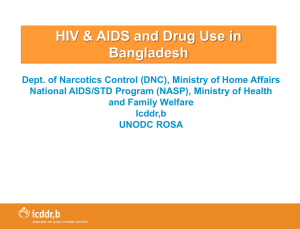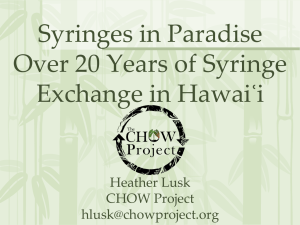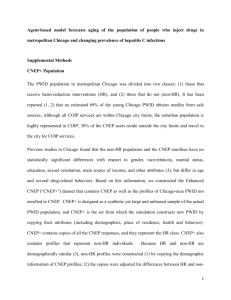HAARP : HIV/AIDS Asia Regional Program
advertisement
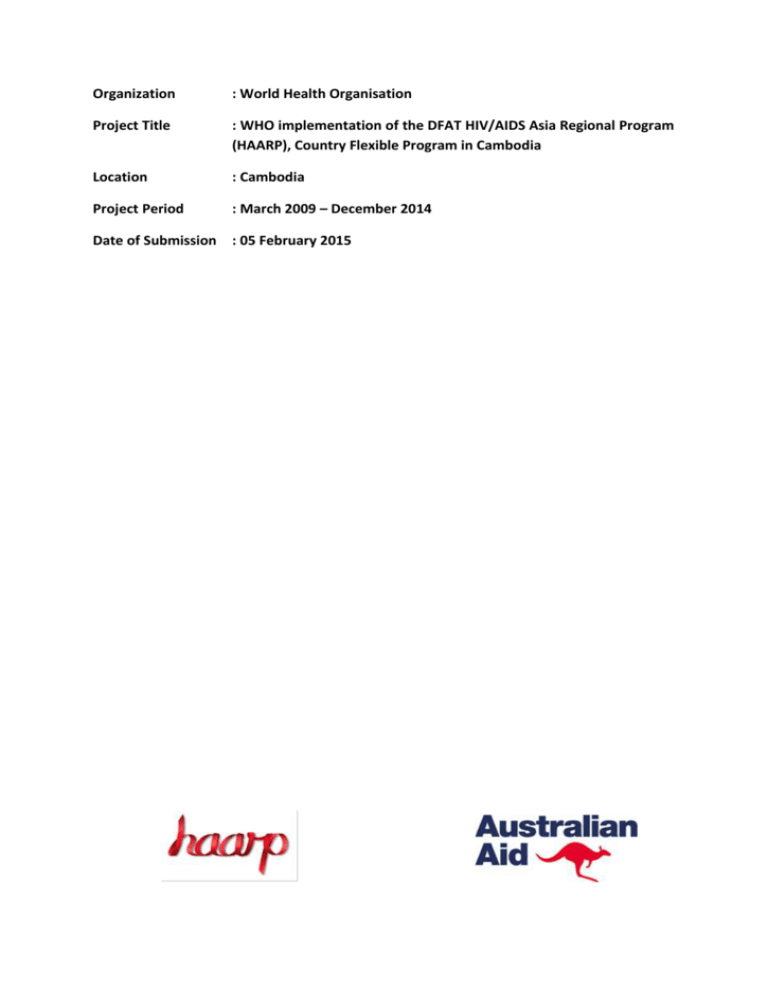
Organization : World Health Organisation Project Title : WHO implementation of the DFAT HIV/AIDS Asia Regional Program (HAARP), Country Flexible Program in Cambodia Location : Cambodia Project Period : March 2009 – December 2014 Date of Submission : 05 February 2015 Table of Contents I. Abbreviations and Acronyms .......................................................................................................... 3 II. Executive Summary / Overview ...................................................................................................... 4 Introduction / Program rationale ........................................................................................................... 4 Objectives ............................................................................................................................................... 4 Program Achievement ............................................................................................................................ 4 Conclusions, key lessons learned and Recommendation ....................................................................... 5 III. The Program Achievements ........................................................................................................ 6 a. Service Deliveries (Needle and Syringe and Methadone Maintenance Treatment) ...................... 6 b. Enabling Environment ..................................................................................................................... 7 c. Capacity building ............................................................................................................................. 8 d. Coordination ................................................................................................................................... 8 e. Activities related to Research/Quality Data.................................................................................... 9 f. Monitoring and Evaluation ............................................................................................................. 9 g. Changes in Drug Use Trends ......................................................................................................... 10 h. Involvement of PWUD/PWID in project implementation............................................................. 10 i. Gender .......................................................................................................................................... 10 IV. Other Issues .............................................................................................................................. 10 a. Lessons learned ............................................................................................................................. 10 b. Recommendations ........................................................................................................................ 11 c. Plans to sustain the program ........................................................................................................ 11 2 I. Abbreviations and Acronyms (1 page) CCC-OC : Country Coordination Committee Oversight Committee CoPCT : Continuum of Prevention to Care and Treatment CoPCT-PR :Continuum of Prevention, Care, Treatment and Psycho-Social rehabilitation DMHSA : Department for Mental Health and Substance Abuse EW : Entertainment Worker FoNPAMs : The Joint Forum for Networks of PLHIV/AIDS and MARPs GF : Global Fund HAARP : HIV/AIDS Asia Regional Program KP : Key Populations MARPS : Most-At-Risk Population MMT : Methadone Maintenance Therapy MoI : Ministry of Interior MoH : Ministry of Health MSM : Men who have sex with men NACD : National Authority for Combating Drugs NCHADS : National Centre for HIV/AIDS Dermatology and STDs NSP : Needle and Syringe Program OST : Opiate Substitution Therapy PCPI : Police Community Partnership Initiative PWID : People Who Inject Drugs PWUD : People Who Use Drugs SOP : Standard Operating Procedure TG : Transgender UNAIDS : The Joint United Nations Programme on HIV/AIDS WHO : World Health Organization 3 II. Executive Summary / Overview (2 pages) Introduction / Program rationale HIV epidemic in Cambodia is concentrated among most-at-risk populations (MARPs), which is recently referred to as key populations (KPs), including sex workers, men having sex with men, transgender people, people who inject drugs (PWID), people who use drugs (PWUD) and their partners. HIV prevalence among PWID is particularly high requiring urgent and robust responses. Among the estimated 1,300 people who inject drugs, only less than 350 have been reached by needle syringe programs (NSP) implemented by several harm reduction NGOs and only less than 150 people are on methadone maintenance treatment (MMT) in 2013. Drop out from MMT is also on the rise. Thus these services are recognized as low performing program by partners including Global Fund. In addition to PWID, the National HIV Health Sector Program Review conducted in May 2013 identified that PWUD selling sex, male and transgender entertainment workers who sell sex, men who have sex with men frequenting saunas and bars, and their partners should be prioritized to control the epidemic. A rapid assessment was conducted to explore and characterize the key populations at higher risk particularly PWID who are not yet reached by needle syringe program in Phnom Penh. This assessment suggested a substantive number of PWID have not been reached by current outreach interventions. These unreached PWID include rubbish collectors, sex workers, construction workers and those working at bus stations. Also, a recent site visit by Country Coordination Committee Oversight Committee (CCC-OC) to harm reduction NGOs revealed little had been done to find unreached PWID including those with overlapping risks in particular sex workers using drugs. Objectives To prevent the transmission of HIV among people who inject drugs in Cambodia, through the provision of a comprehensive package of interventions including opiate substitution therapy (OST) and other harm reduction services including needle and syringe program (NSP), Cambodia. Program Achievement 1) HAARP program funded by the Australian government and the Global Fund have been contributing financial support for harm reduction in Cambodia in the last several years. While HAARP program officially closed at the end of 2014, the Global Fund Country Coordination Committee (CCC) in Cambodia plans to submit its HIV Concept Note to the Global Fund in February 2015. The Global Fund requires a 4 proposal of robust national strategic plans as foundation of activities. However, there is no national strategic plan that covers harm reduction interventions. End of 2014 and beginning of 2015, under WHO’s technical supports in collaboration with the Ministry of Health (MoH) and other concerned partners, the National Strategic Plan for Harm Reduction for 2015-2020 were drafted. This Strategic Plan including its costing will be finalized in February 2015 and endorsed by the Ministry of Health. The Strategic Plan is a core document for resource mobilizations for harm reduction interventions in Cambodia. National Strategic Plan for Harm Reduction stipulates the establishment of a multidisciplinary team to search new/dropped-out PWID and assist them to access harm reduction service and other related services. This team should be comprised of four-five members from Department of Mental Health and Substance Abuse (DMHSA), epidemiology graduates of School of Public Health, WHO, implementing NGOs, PWID networks, and other KP networks who will search unreached PWID through multiple methods including regular program data review, active peer search, rapid assessment and focused research. 2) Recently, WHO in collaboration with stakeholders has developed a proposal for harm reduction to be included in the HIV concept note to the Global Fund. The proposal contains key activities and new innovative strategies to improve needle and syringe program and increase uptakes to methadone maintenance therapy (MMT). The HIV concept note from Cambodia will be submitted to GF in February 2015. 3) In 2012, WHO, in close collaboration with other key partners, developed the subdecree for drug dependence treatment for the Kingdom of Cambodia. The purpose of this sub-decree is to formalize MMT services as a government program and to ensure that there will be a clear directive in terms of overall coordination and management of treatment service for PWUD/PWID among and between the government institutions and implementing NGOs. Conclusions, key lessons learned and Recommendation 1) For needle and syringe programs, it is critical to start establishing and operationalizing the active team as highlighted in the national strategic plan. This team will play a critical role in improving needle and syringe program and other harm reduction interventions. 5 2) Methadone Maintenance Therapy (MMT) needs to be scaled-up urgently, by increasing the clients in the current MMT clinic and implementing recommendations made by several experts from other countries. Among those recommendations, taking home doses for the stable patients and allowing a limited number of take home doses for special circumstances such as national holidays, special events, work required travels, family celebrations or emergencies are crucial for the implementation. It is very necessary to undertake a patient satisfaction survey at least every year to identify key patient concerns and to improve the program. In addition, it will be very useful for the MMT clinic to start discussing co-morbidities in methadone patients and to engage other relevant health disciplines. Furthermore, it is needed to develop communication strategies to mobilize funding for harm reduction program from in-country and external donors and funders. Also, pharmacy of MMT clinic needs to take strong leadership/responsibility in managing stock of methadone to avoid any shortage of stock in the near future and secure access to essential medicines if possible. 3) Department of Mental Health and Substance Abuse (DMHSA) needs to take immediate actions to finalize and formalize all the key documents such as national strategic plan for harm reduction interventions, sub-decree for drug dependence treatment, guidelines for needle and syringe program and MMT clinical guidelines/SOPs and other relevant documents. The official endorsement of these documents will help implementers to improve the programs. III. The Program Achievements (10 pages) Program activities and achievements summarized by strategic objectives a. Service Deliveries (Needle and Syringe and Methadone Maintenance Treatment) 1) With the financial support from HAARP, Needle and Syringe Program Manager was recruited by WHO and seconded to DMHSA. He has been supporting the implementation of the Conceptual Framework for the CoPCT-PR for PWUD/PWID and the related SOP for the Boosted CoPCT for MARP’s with specific focus on the management and coordination of the comprehensive harm reduction programme. The work includes, and prioritises, the provision of sterile needles/syringes to PWID to prevent the transmission of HIV (and other blood-borne diseases such as Hepatitis C) through the sharing of contaminated equipment by PWID. Moreover, his contribution to the harm reduction program includes supervising the day-today implementation, managing and coordinating the needle/syringe programme (NSP) and making cost-effective linkages to other health interventions, especially the methadone maintenance therapy (MMT) programme and HIV testing, treatment and care. He is also 6 responsible for building and maintaining partnerships with other government institutions, NGOs and other partners in the health, social and economic sectors, as well as the drug control sector in Cambodia. 2) National Authority for Combating Drugs (NACD) endorsed the policies and guidelines for implementing needle and syringe program in health sector in Khmer version in 2014. The English version is being translated. 3). In addition, Methadone clinical guidelines have been recently finalized and the practical aspects for the implementation have been also refined with the providers and NGO partners through consultative meetings. The Department of Mental Health and Substance Abuse will need to seek approval from MoH for an official endorsement. b. Enabling Environment 1) Police Community Partnership Initiative (PCPI) was created in late 2012. It involves police, local authority, MARPs representative, NGO and Health Care worker who work as team in coordinating and facilitating services delivery for MARPs. PCPI encompasses all arrangements and activities at the national, provincial, district and commune levels aiming at facilitating and supporting the implementation of all services for MARPs – which will be delivered by government health facilities and NGOs. The outcomes of PCPI over the past several years include positive police’s attitude towards MARPs and friendly involvement of police in coordinating and facilitating training sessions and related events. In addition, the majority of MARPs expressed that they have no longer fear of police and came forward to seek care and services. Moreover, many entertainment establishment owners are more confident in cooperating with the police and NGO partners and displaying condoms in their venues. 2) Apart from PCPI, The Joint Forum for Networks of PLHIV and MARPs (FoNPAMs) was established in mid-2011 as an informal platform for the national networks representing people living with HIV (PLHIV) and Most- At-Risk populations (MARPs) in Cambodia. The members of the network are the Cambodian People Living with HIV Network (CPN+), Cambodian Community of Women Living with HIV (CCW), Antiretroviral Users Association (AUA), Women's Network for Unity (WNU), Bandanh Chatomuk (BC) and Korsang (Representing people who inject drugs (PWID) in the absence of a network of PWID. The objectives of FoNPAMs are to promote greater partnership and collaboration, harmonization of strategies and activities between community networks and jointly advocate for enabling environment for the MARP communities. The FoNPAMs promote understanding among different networks, identify key interlinked issues, develop joint initiatives, and enhance ownership through participatory approaches. It also aims to represent a joint voice of PLHIV and MARPs at national and international levels. 7 With financial and technical support from UNAIDS, monthly meetings of FoNPAMs have been organized regularly. During these meetings, information about key activities, events have been updated and exchanged among the members. In addition, issues related to arrests of MARPs by police, access to essential services including ARV treatment, and stigma and discrimination faced by MARPs have been discussed. Moreover, capacity building and support have been providing to FoNPAMs to address the issues above, and the members have been working actively to enable MARPs in accessing health service they need. WHO has been always consulted by UNAIDS and members of FoNPAMs when it comes to issues related to harm reduction interventions and other problems concerning PWUD/PWID. c. Capacity building 1) Trainings and refresher trainings have been conducted by Dr David Jacka, from WHO in Vietnam and other experienced consultants. Subjects covered include concerning patient / client record keeping, dosing records, prescriptions analysis problem solving, dose increases, referral services, management of HIV cases, assessment modalities, and drop-outs / death cases. 2). All MMT staffs were supported to take a general English course every day after working hours. This support was to help them understand the existing training materials, motivate them to search and read English articles through the internet and encourage them to interact with foreign visitors to the clinic d. Coordination In addressing the challenges of decreased external funding for the HIV response in Cambodia, WHO has been leading the process of focusing and streamlining HIV activities and services through technical and programmatic prioritization. WHO has been working intensively with national programs, development partners, implementing NGOs, communities and donors including GF, USAID. Furthermore, during the process of developing National Harm Reduction Strategic Plan and the inclusion of harm reduction in the GF HIV concept note, WHO coordinated, supported and facilitated concerned national programs, implementing partners including non-harm reduction NGOs, and the PWID community. To address challenges faced by needle and syringe program, especially its low coverage, WHO coordinated a series of discussions and consultations have been conducted among the government programs, harm reduction NGOs and development partners. . WHO was advised to lead and coordinate several assessments in close collaboration with UNAIDS, FHI360, HAARP and implementing NGOs, to understand barriers which prevent 8 PWID and their partners from accessing needle and syringe program and other harm reduction intervention. Responding to the needs of other high risk key populations including overlapping risk such as sex workers using drugs, WHO has been coordinating and working with the National Centre for HIV/AIDS, Dermatology and STDs (NCHADS) to explore the existence of these populations, characterize them and upgrade the existing B-COPCT strategy as part of the Cambodia 3.0 Initiative. For the past several years, WHO and partners have attempted to scale up services for PWUD/PWID and establish linkages between MMT and other HIV services. Discussions have been made to facilitate the DMHSA and NCHADS to maximize the current HIV service delivery mechanism, which is available nationwide the discussions have also aimed to provide harm reduction services for PWUD/PWID with overlapping risk. e. Activities related to Research/Quality Data One qualitative assessment was conducted in October 2013 by a Cambodian consultant who has many years of experience in working with key populations. This assessment intends to understand characteristics of key populations who are not reached by needle and syringe program in Phnom Penh and underlying reasons. These assessments led to discovery of a significant number of unreached PWID who are highly vulnerable, construction workers, and seafarers. In addition, these assessments revealed that a majority of PWID currently reached didn’t have connections with PWID who were served by the needle syringe programs. These findings informed the national programs and implementing partners to adjust current programs to reach higher risk groups. Besides the assessments, WHO also worked with the implementing NGOs to review their existing data and document their services and operations in order to find ways to better reach high-risk key populations. Based on the findings from the assessments and the data review, the concept note on sharpening the Boosted-COPCT response for populations at highest risk was developed. The concept note attempts to strengthen the Boosted CoPCT intervention to reach higher risk populations which include the groups who have overlapping risks and vulnerability to HIV. f. Monitoring and Evaluation A core group on Rapid Monitoring Analysis for Actions (RMAA) has been recently established by NCHADS. This core group is a sub-group of the existing Sub-Technical Working Group on Strategic Information for Cambodia 3.0 Initiative. 9 The group meets every two weeks to review newly identified HIV reactive cases and their status of HIV diagnosis confirmation, as well as enrolment in pre-ART care and ART services. Together with other partners, WHO has been supporting NCHADS to strengthen its capacity to manage RMAA for improving HIV case detection among MARPs including PWID and other populations as well as retention in case. . g. Changes in Drug Use Trends N/A h. Involvement of PWUD/PWID in project implementation PWUD/PWID has been involved in the development of the National Strategic Plan for Harm Reduction and drafting the harm reduction component of the GF Concept Note since their initial stage. Small group discussions were organized by each NGO and in larger group meetings to facilitate their participation. As a result, PWUD/PWID contributed significantly to the Strategic Plan and GF Concept Note in various ways. For instance, PWID raised concerns about feasibility of proposed new approaches to scale up needle and syringe coverage, and provided ideas to make the approaches realistic and grounded. i. Gender N/A IV. Other Issues (3 pages) a. Lessons learned The needle and syringe program coverage has been very low, uptake to methadone maintenance treatment (MMT) hasn’t increased, and drop-out has arisen. In addition, the current approach in finding PWID is not effective, therefore alternative approaches need to be implemented and expanded. Furthermore, the estimation of unit cost of various HIV services in Cambodia using the Asian Epidemic Model (AEM) revealed that the unit cost of the outreach of needle and syringe program (NSP) is very expensive, much higher than other KPs. The village-commune safety policy, reactivated since early 2011 by the Ministry of Interior (MoI), has reduced the opportunities for PWUD/PWID and other MARPs to access essential health and social services. Also, this policy has driven people underground and made great difficulties for NGO staff to reach them. Therefore hidden PWUD/PWID continue to stay hidden. Consequently, evidences of arrests and prosecutions have been noticed on a quite regular basis, while an effective mechanism to address this complex social problem is missing. 10 From the legal perspective, the current law on illicit drug control has created additional unnecessary challenges for PWUD/PWID since a number of its articles are not in favour of PWUD/PWID but rather creates more administrative difficulties due to heavy procedures (which demands the involvement of lawyer and/or prosecutor in the process of enrolment for treatment) before treatment or care can be delivered to the patient. Moreover, punitive approach has been applied in a number of articles of the law, while supporting approach has not been much considered. In addition, the current communication and collaboration between the HIV program and other related national programs; and between harm reduction NGOs and Non-harm reduction NGOs have not been functioning enough to support effective scaling-up of needle and syringe program. b. Recommendations Start operationalizing the team to search new/dropped-out PWID and assist them to access harm reduction service and other related services. Streamline frequency and intensity of existing services. Implement low cost approaches of needle and syringe program such as secondary distributors, pharmacies, street vendors and fixed boxes but can maintain current patients in the services. Establish linkages between harm reduction NGOs and non-harm reduction NGOs targeting PWID with overlapping risk. Improve MMT program to increase uptake and retention Encourage MoH to advocate to NACD to draft/revise relevant sub-decrees (proclamations) to incorporate provisions aiming at minimizing difficulties and negative implications for PWID to access harm reduction services. Continue to explore an opportunity to engage DMHSA with NCHADS to maximize HIV service delivery mechanisms to provide a full package of harm reduction to MARPs . Support and urge DMHSA to make MMT program as flexible as it can within the confines of local practice and law and have the view that the ultimate goal is stabilisation of individuals to re-gain family connections, jobs with incomes and a reason to remain stable as the main outcome of this kind of program is social stability through medical treatment. c. Plans to sustain the program Describe the activities needed to be undertaken to sustain the program Mobilize domestic and international funding for harm reduction services utilizing the National Strategic Plan for Harm Reduction. 11 Establish the model of targeted and streamlined harm reduction interventions which are most effective and efficient in achieving program outcomes, according to the National Harm Reduction Strategic Plan and GF Concept Note. Particularly, WHO plans to support MoH to finalize and implement the national harm reduction strategic plan and assist the implementing NGOs to establish the active team and operationalize the new proposed approaches. Coordination with other groups WHO and relevant partners continue to ensure coordination and facilitation of concerned national programs, implementing partners including non-harm reduction NGOs and as well as the PWID community until the coordinated national leadership has been firmly established. Integration of harm reduction with HIV health service would not only improve effectiveness, but also efficiency. If the sustainability plan is already being implemented by a mechanism, please describe the status. As mentioned above, it is critical to ensure the effective implementation of the National Harm Reduction Strategic Plan and the harm reduction component of the GF Concept Note. Especially, it is imperative to establish and expand the model of targeted and streamlined harm reduction interventions and to integrate harm reduction with HIV health services for the sustainable service delivery in the years to come. 12
